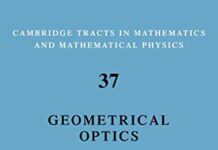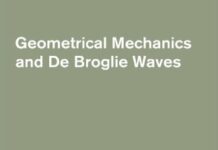
Ebook Info
- Published: 1978
- Number of pages: 336 pages
- Format: PDF
- File Size: 14.71 MB
- Authors: J. L. Synge
Description
Mathematicians, theoretical physicists, and engineers unacquainted with tensor calculus are at a serious disadvantage in several fields of pure and applied mathematics. They are cut off from the study of Reimannian geometry and the general theory of relativity. Even in Euclidean geometry and Newtonian mechanics (particularly the mechanics of continua), they are compelled to work in notations which lack the compactness of tensor calculus. This classic text is a fundamental introduction to the subject for the beginning student of absolute differential calculus, and for those interested in the applications of tensor calculus to mathematical physics and engineering.Tensor Calculus contains eight chapters. The first four deal with the basic concepts of tensors, Riemannian spaces, Riemannian curvature, and spaces of constant curvature. The next three chapters are concerned with applications to classical dynamics, hydrodynamics, elasticity, electromagnetic radiation, and the theorems of Stokes and Green. In the final chapter, an introduction is given to non-Riemannian spaces including such subjects as affine, Weyl, and projective spaces. There are two appendixes which discuss the reduction of a quadratic form and multiple integration. At the conclusion of each chapter a summary of the most important formulas and a set of exercises are given. More exercises are scattered throughout the text. The special and general theory of relativity is briefly discussed where applicable.
User’s Reviews
Reviews from Amazon users which were colected at the time this book was published on the website:
⭐This book was phenomenal in teaching how Tensor Calculus works. Difficult but well written.
⭐I did a graduate level class in tensors back in 1971, and thought that this book would be good for review (if you can call it review after 40+ years) and self-study. The book takes the classical “indices” approach, which was how it was done back in my day, too, so I thought everything would be fine.Now, not being familiar with a modern differential geometry approach, I won’t criticize the book as being dated. But I will criticize it as being a little obscure. Tensor calculus is inherently a sort of messy topic, and not the clearest thing ever, so there’s all the more reason to provide text and explanations that don’t do a lot more than sketch out the ideas and leave the rest as the proverbial “exercise for the reader.”The book is thorough and complete. Everything of importance to the classical approach is covered, and more. But if you haven’t seen any of this before and you’re attempting self-study, I think it’s going to be a lot of work. Not that work is bad, but some of it is unnecessary. I’d rather concentrate on applications than on filling in the sketchy explanations provided in this book.I’d have to say, pass this one up and get something, if not newer, then at least more detailed in its exposition.
⭐I find it rather strange that several of the negative reviews of Synge & Schild are really negative opinions about the lack of elegance of tensors, compared to the new-fangled differential forms.This is like blaming the author of a book on the grammar of a language, because you think the grammar is too complicated. Sorry, but the author of the book can only explain as well as he/she can the grammar that exists, it’s not within his scope to improve upon it!This book is a relatively easy-to-read and carefully motivated text on tensor calculus, a subject that does tend to lead to that eye-glazing-over effect because of the numerous indices. It does a very good job of keeping the focus on the concepts, without getting too bogged down in the equations – most of the time.Does it need to be said that this subject is still useful, despite its comparative inelegance, because so many classic texts and articles on general relativity use this language? Will those who scorn to deal with indices demand that all these papers be properly translated into differential forms before they deign to read them?
⭐Absolutely a great book. I have read it twice and have learned a great deal from it. It has answered some questions that have been bugging me for years. Well worth the read for anyone serious about learning Tensor Calculus.
⭐My background is being an electrical engineer with casual interest in physics. I was trying to start understanding more about relativity.Being honest this was my first book on the topic of tensors. What can I say? tough start. Don’t even bother if you aren’t a graduate student (IMHO). Complex notation, fast paced (not for the student), few resolved exercises, no companion material (web pages or others).I think this book is thought to be a companion book for someone who already has a certain knowledge about tensors.In the book, there are many exercises but none of them is resolved in details, on the contrary, they are left to the reader as a “homework”. Which is a pity because is in the exercises where you can hope to find some help to understand this complex subject.As far as I know There is not a place in Internet where one can check the resolution of the exercises in this book.
⭐This book greatly enhanced my understanding of general relativity and special relativity, this book for the subject was written at an most advanced level I would believe.
⭐First, read a review in Bulletin Of The American Mathematical Society (1951, Vol.57, No. 6): “…worthwhile introduction.” Second, read the Preface: “…this book is intended as a brief introduction…without claim to be exhaustive in any particular…” Third, note the initial date of publication, 1949 then reprinted five times from 1949 and 1962 (thus a rather popular textbook for its time). Fourth, note: This book is prerequisite for the two-volume set by Synge, Special Relativity and General Relativity, read: “…the reader is expected to be familiar with the techniques of tensor calculus, the notation used is that of Synge & Schild. “Now, you will not be exposed to differential forms or differentiable manifolds. But, that is not the book’s intent, therefore Synge and Schild can hardly be faulted for the omission ! You need to turn elsewhere for that (I turn to Bishop and Goldberg). Now, you will not get a survey of advanced calculus or review linear algebra. You turn elsewhere for that (say, chapter one of Tensor Analysis, by Sokolnikoff). But, you will get a personal view of tensor calculus from two masters. Replete with simple exercises (permeating the prose) and even more challenging exercises (that is, end-of-chapter problems). The simpler exercises (perhaps two per page) are to be done within that section. Do not ignore them, they provide instant reinforcement as to whether (or not) you have understood the simpler parts of the subject. And, what of prerequisites ? That is a stumbling block here, for it is difficult to pin down what is presupposed of the reader: one will need (at minimum) exposure to such things as Jacobian of transformation, facility with partial derivatives and mathematical maturity: Courant’s Calculus is usually referenced. Now, then, a survey of the contents:(1) We read: ” The vector is considered as having absolute meaning, but the numbers which describe it depend on the coordinate system.” (page 9). First chapter (twenty-five pages) expounds upon the usual algebraic and transformation properties of tensors. Problems #12 and 17 (page 25) will be of interest for future studies. A total of 32 exercises for the reader spans the content of this chapter. If one completes most of these (15 scattered throughout, 17 end- of- chapter), continuation of the text is recommended. If not completed, all going forward will prove obscure !(2) Here, chapter two, Riemannian space, the text gets interesting. First: recall determinants and scalar products. Then, recall the Euler-Lagrange equations from simple calculus of variations (say, Boas). Note the older notation used for Christoffel symbol. With that in mind, proceed. A pretty demonstration is met regards angles in Riemannian space (page 35). The following ten pages: a whirlwind survey of variational methods. A lucid companion to other expositions. A highlight, covariant differentiation: “an operation which is applied to a whole set of quantities,” and “Christoffel symbols are clumsy to handle in explicit calculations and we shall avoid their use whenever possible.”(page 53). Note the interesting computation regards spherical coordinates and Christoffel symbols (pages 54-58).(3) Of Curvature, read: “…the great charm of classical geometry lies in the interplay of visual intuition and precise analytical concepts.” From covariant derivative to noncommutivity (page 84) to geodesic deviation (pages 90) to parallel transport (page 99). Nothing here needs to be relearned later ! This is a very good exposition. Exercises are amplified through references to applications in General Relativity.(4) Previous chapter sets the stage for the next one, Special Types of Space. Here, constant c. Note: “the technique of cartesian tensors is available only when two conditions are fulfilled, the space is flat and the coordinates are homogeneous.” ( age 130). Problem #14 (page 140) will prompt the student to translate and to verify eleven vector identities for cartesian space. Most of these identities are found on the inside cover of Jackson’s Electrodynamics (1975, second edition). Again, Synge and Schild proves its efficacy !(5) Applications to dynamics, next. Applications to electromagnetism follows. Obtain the Mechanics text, by Synge and Griffiths, it will come in handy for the dynamics. These chapters will serve one in good stead for the future. Read: “only the fusion of the electric and magnetic fields has physical significance.” (page 232). The notation is of the older-variety, so keep your wits about you. (For instance: Greek index range over 123, Latin index 1234).(6) As with many an introduction, the conclusion here focuses on introducing Green and Stokes theorems.That presented here will not supplant the modern approach of Spivak (1965, Calculus On Manifolds). That presented here will provide preliminary to that modern approach. For instance, Grassmann is referenced with regards to nonmetrical concept of extension. Read: “which bears the same relationship to volume as vector displacement bears to length.”(page 253).(7) There we have it, an introduction which is really a bit more than introductory. For its time (1949) this would have been a useful start. The exercises span the gamut: from routine to creative. The prose is lucid, concepts are simply presented. Derivations are straightforward. Nothing here needs to be re-learned, despite the older notation and terminology. The exercises are a goldmine for unearthing. No differential forms, no manifolds and little real analysis, linear algebra, or topology. So, this really is an introduction. That does not imply easy. You will have to work at it. Recommended for collateral study and enrichment.
⭐To learn tensor analysis
⭐No doubt it is a good book if one wantsto understand differential geometry and its applications
⭐Excellent book. Well written and I recommend it to everyone who is interested in this subject.Thank you for the excellent delivery service too.
⭐ok
⭐Another pretty well tensor analysis book from Dover.
Keywords
Free Download Tensor Calculus in PDF format
Tensor Calculus PDF Free Download
Download Tensor Calculus 1978 PDF Free
Tensor Calculus 1978 PDF Free Download
Download Tensor Calculus PDF
Free Download Ebook Tensor Calculus


